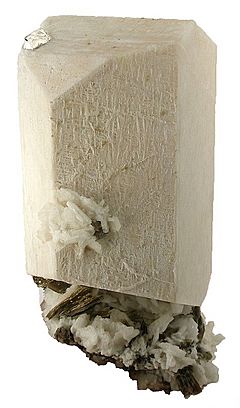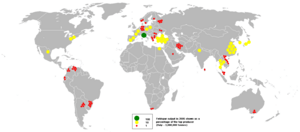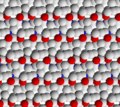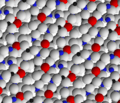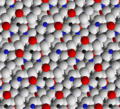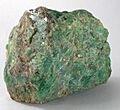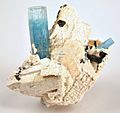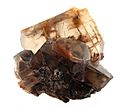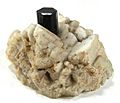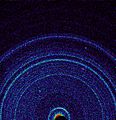Feldspar facts for kids
|
||||||||||||||||||||||||||||||||||||||||
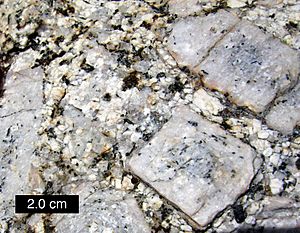
Feldspar is a group of common minerals found in many rocks. It makes up a huge part of the Earth's outer layer, called the crust. In fact, up to 60% of the Earth's crust is made of feldspar!
Feldspar forms crystals from hot, melted rock called magma. You can find it in rocks that form deep underground (intrusive rocks) and rocks that form from lava on the surface (extrusive rocks). It also appears in many metamorphic rocks and sedimentary rocks.
Feldspar usually looks reddish or pale pink. It's quite hard, about a 6 on the Mohs scale. This means it's about as hard as glass.
There are two main types of feldspar. Both are made of silica (silicon and oxygen) and aluminum:
- Orthoclase (also called "alkali" feldspars): These minerals have a similar chemical makeup (KAlSi3O8). Sometimes, sodium can take the place of potassium. They look different depending on how and where they formed.
- Plagioclase feldspars: This group is a mix of two chemicals: Albite (NaAlSi3O8) and Anorthite (CaAl2Si2O8). Each plagioclase feldspar is unique, depending on how much of each chemical it contains.
What's in a Name?
The name feldspar comes from the German words Feld (meaning "field") and Spat (meaning "flake"). Spat was a word for a rock that could easily break into flakes.
The term Feldspat was first used in the 1700s. It might have referred to how common this mineral is in rocks found in fields. Or, it could mean how it appears as "fields" within other rocks like granite. The change from Spat to -spar happened because of the English word spar, which describes a clear mineral that breaks easily.
How Feldspar Changes Over Time
Chemical weathering is when rocks break down due to chemical reactions. For feldspars, this happens when they react with water, a process called hydrolysis. This reaction turns feldspar into clay minerals like illite, smectite, and kaolinite.
Feldspar dissolves best in water that is either acidic or basic, not neutral. The faster it dissolves, the faster it weathers. When dissolved feldspar reacts with certain charged particles (ions) in water, it forms clays. This process also creates new ions in the water.
Because feldspars are so common in the Earth's crust, clays are also very common. About 40% of the minerals in sedimentary rocks are clays. Clays are the main minerals in mudrocks, which are very common sedimentary rocks. They are also a big part of soils.
Feldspar that has turned into clay looks chalky. Unweathered feldspar looks more like glass. Feldspars, especially plagioclase types, are not very stable near the Earth's surface. This is because they form at high temperatures deep inside the Earth. This instability is why they easily break down into clays.
Rocks with a lot of feldspar usually mean that the rock material didn't weather much before it was buried. This suggests it traveled a short distance in cold or dry conditions, and was quickly covered by other sediment. Sandstones with lots of feldspar are called arkoses.
Uses of Feldspar
Around 20 million tons of feldspar were produced in 2010. The top countries producing it were Italy, Turkey, and China.
Feldspar is a key ingredient in many products:
- Glassmaking: It helps make glass harder, more durable, and resistant to chemicals.
- Ceramics: This includes things like tiles, pottery, and toilets. The chemicals in feldspar act like a "flux." This means they lower the melting temperature of the ceramic mixture. When heated, the flux melts early and creates a glassy material that holds all the other parts together.
- Fillers: It's also used as a filler in paint, plastics, and rubber.
In the United States, about 66% of feldspar is used to make glass, including glass containers and fiberglass. The rest goes into ceramics and other uses like fillers.
A cleaning product called Bon Ami used feldspar as an abrasive. There was a large feldspar mine near Little Switzerland, North Carolina. This mine was once the biggest feldspar mine in the world, and North Carolina was the top producer.
Scientists also use feldspars for dating things in earth sciences and archaeology. They can use methods like potassium-argon dating and luminescence dating to figure out how old rocks or ancient artifacts are.
In 2012, the Mars Curiosity rover found a rock on Mars that had a lot of feldspar in it!
Images for kids
-
Specimen of rare plumbian (lead-rich) feldspar
-
First X-ray view of Martian soil—feldspar, pyroxenes, olivine revealed (Curiosity rover at "Rocknest", October 17, 2012).
-
Lunar ferrous anorthosite #60025 (plagioclase feldspar). Collected by Apollo 16 from the Lunar Highlands near Descartes Crater. This sample is currently on display at the National Museum of Natural History in Washington, D.C.
See also
 In Spanish: Feldespato para niños
In Spanish: Feldespato para niños


